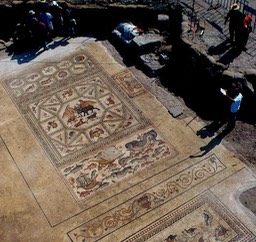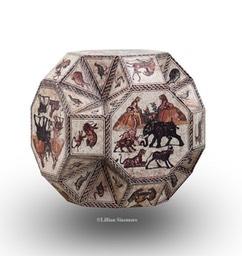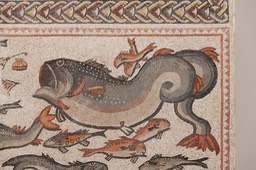In three videos above:
1. Patricia and Phillip Frost Art Museum director Jordana Pomeroy introduces a shift in programming at the museum and connects the 1700-year old Roman mosaic from Lod, Israel that's on exhibit with the Art of Video Games also on view. "One word: pixelation!"
2. Lillian Sizemore is a scholar and long-time practitioner of of mosaics. She describes both the lively workshop setup of Roman times and her fascination with the "sacred geometry" of the ancient world as represented in the Lod Mosaic.’’ Photo: John Lund
3. Jacques Neguer is head of art conservation for the Israel Antiquities Authority and brings his hands-on and scientific technical expertise to bear in discussing fine points of the Lod Mosaic restoration. Photo courtesy Israel Antiquities Authority and the Shelby White and Leon Levy Lod Mosaic Center
Roman-era Lod Mosaic from Israel Delivers Vital Vision
BY GEORGE FISHMAN
Who says you have to be new to be noteworthy in Miami? The Patricia & Phillip Frost Art Museum FIU is hosting an enormous Roman-era stone mosaic floor that features a menagerie of wild and domestic mammals, a plethora of fish, two sea monsters and a pair of sailboats — all entwined in a complex system of panels and borders. And it comes with at least one mystery: Who commissioned it?
Fifty feet long and 27 feet wide, this exquisitely detailed mosaic artwork was discovered in 1996, just prior to a road-widening project in the town of Lod, Israel, near the Tel Aviv airport. Quick intervention by the Israel Antiquities Authority prevented its destruction, and by 2009 funds were raised to painstakingly remove, conserve and remount it on rigid panels.
Patricia and Phillip Frost, whose names are familiar as major patrons of South Florida cultural institutions, have underwritten the mammoth logistical enterprise of bringing this archaeological and artistic “rescue” to Miami for a special visit. The expression “not-to-miss” is overused, but the Lod Mosaic is concluding its world tour of exclusive venues and will soon be installed in a new visitor center in its hometown. A separate “bonus” vine scroll frieze, also on view, has never before traveled outside Israel.
Alongside the fascinating story of the Lod Mosaic’s discovery and restoration, this complex patchwork of interlocking pictorial panels and elaborate borders contains insights into what has and hasn’t changed in the past 1,700 years. It’s also a marvel of graphic art and virtuosic craftsmanship. Before delving into the history and iconography, visitors should simply revel in the physicality of this monumental object. It’s an enormous layer cake of stones, bound together with lime mortar and topped with a complex stone painting created by exquisitely skilled artisans who cut, shaped and placed approximately two million stones.
In Greek and Roman times, mosaic pavements and wall decorations adorned baths, grottos, palaces, temples and churches from Syria to Spain and from North Africa to Britain. (The Greek word for “muse,” mousai, is also the root for “mosaic” and “museum.”) Their durable but flexible lime mortars, developed through a multigenerational tradition, have withstood centuries of foot traffic and even gradual shifts of underlying terrain. The Lod Mosaic is exceptional both for its sophisticated design and pristine condition.
DISCOVERY
In 1996, archaeologist Miriam Avissar, working for the Israel Antiquities Authority, probed the area near the road-widening project to assure it would not impinge on relics that might be hidden underground. Her spade revealed the tail of a tiger, finely executed in mosaic, about three feet below grade. The area was urgently excavated to ascertain the mosaic’s size and condition, then reburied for protection.
In 2009, with funds provided by Shelby White and Leon Levy, the prodigious removal and remounting began. “There are practically no machines to help us,” said Jacques Neguer, head of art conservation for the Authority, who has been involved with the project from the beginning.
First, he explained, the mosaic was divided into 30 large but manageable sections (4 by 8 feet or so), by cutting thin vertical lines through spaces between the tesserae (mosaic tiles), creating a giant jigsaw puzzle. Canvas was then glued to the mosaic surface with a water-soluble PVA adhesive. Long chisels were driven horizontally under the mosaic, separating it from its mortar setting bed. Each mosaic section could then be rolled up around a cylindrical wooden core, like a 2,500-pound rug. The process was subsequently reversed, unrolling the mosaic sections onto a rigid platform that was lifted off-site by crane.
Separating the mosaic from its underlayment revealed a strikingly detailed underpainting — essentially, a five-color fresco — that had guided layout and placement of the individual tesserae. Usually, a simpler one-color design drawing was employed. “To divide this layer from the mosaic is an extremely dangerous and risky operation, but we succeeded,” Neguer said.
A long and complex conservation process culminated in the mosaic’s remounting on panels, supported with modern honeycomb laminate. This treatment allowed the mosaic to travel worldwide, providing public access and scholarly analysis. Neguer, his associate Ghaleb Abu Diab, Frost Museum staff and the crew from LogicArt Miami worked carefully to maneuver and interlock the sections and replace any tesserae that might become dislodged.
HISTORICAL PERSPECTIVES
Jordana Pomeroy, director of the Frost Museum, said this exhibition is part of a new initiative “to ignite historical and global engagement through the language of art. . . . As a unit of the university, we can do anything we want.” And as such, she explained, they are less inclined to follow most other local institutions’ principal focus on contemporary and Latin American art.
Interestingly, the Lod Mosaic exhibition is paired with “The Art of Video Games,” (organized by the Smithsonian American Art Museum), which explores the 40-year evolution of video games as an artistic medium. “It’s about pixilation,” Pomeroy said. “That is the wonderful connective thread. You’re looking at video games from the early ’80s to today, and right across the hallway you look at ancient pixelation, in effect.”
Both sets of artists achieve realism and fantasy, animated movement, storytelling and spectacle. And both exhibits provide historical perspective on their respective times.
Teens who came of age with the Xbox will view the Tetris and Pac-Man “relics” of the early ’80s with very different emotions from the baby boomers who graduated from pinball machines to consoles with increasingly high resolution and immersive video displays. The mosaics may not be literally interactive (no joysticks), but visitors confront dramas of bloody hunts and the perils of ocean travel amid sea monsters. Today’s gamers also confront moral dilemmas as they squeeze triggers, and video artists question our place in the cosmos.
Visitors can marvel at the skill sets, imagination and technologies in both artistic mediums. (Unfortunately, no contemporary mosaics are included.)
Pomeroy is especially gratified to present the extremely rare mosaic exhibition to students and other audiences who may not have traveled far. With related programming she also hopes to inspire interest in the fields of history, archaeology and preservation.
For instance, Michael Maunder, interim director of The Kampong National Tropical Botanical Garden in Coconut Grove, recently discussed the “lost world” of plants and animals represented in the mosaic. Habitat and species loss are dramatically portrayed in the Lod Mosaic’s “exotic” animals — some of which were once native to that region — but no longer exist there.
Upcoming presenters will spotlight protection of imperiled world heritage monuments as well as local historical and pre-historical preservation — vital in a region where architectural gems are often bulldozed and replaced with ugly vanity projects.
CLOSE LOOK
The size, shape and location of the Lod floor suggest that it was the reception area of a villa whose owner had the means to invest in this impressive welcome for his guests. Who was he? The various nonnative mammals depicted (elephant, giraffe, wild bull, lion, tiger, leopard, rhino, ibex) have led to speculation that the patron was an importer of exotic animals for the popular Roman arena “games.” Two oceangoing freighters traverse the marine scene, and sailing enthusiasts will enjoy scrutinizing the careful representation of their rigging.
The city of Lod was an important city for textile production and trade. Largely Jewish, and twice destroyed during wars, it became a Roman colony, and when the mosaic was created, pagans, Jews and even Christians resided there. Other contemporary mosaics featured hunters, farmers, winemakers, gladiators, lovers — and the gods they worshipped. Not here. Nor do we find Christian or Judaic symbols, inscriptions or figures. Suffice to say the wealthy patron was keen to welcome and impress his visitors, but not to champion any religious affiliation.
The Lod Mosaic is remarkable for incorporating both “stock” elements and unique features. For example, bowls of fruit, fish, vines, livestock, domestic and game animals suggest the wealth and bounty of the patron. So do the jaguars hanging off a large golden vessel. The peacock symbolizes both prosperity and immortality. In the mosaic, we see fish in a cornucopia-like basket and also in the marine scene where they surround the ships. Realistic “portraits” of rockfish, bream, snapper and barracuda mix it up with a curly-tailed fantasy whale (suggesting Jonah’s adventure?) and in the central octagon panel, a mythological sea monster with a dog-like head.
“This mosaic is very North African by composition, by layout and is very open to the Roman world,” Neguer said. “This is not a local mosaic; this is the Roman Empire.” Mosaic “studios” were frequently itinerant and often carried pattern books, leading to wide dispersal of imagery and ideas.
Although sketches or writings from the site aren’t around, Lillian Sizemore, a longtime mosaicist and scholar, suggests a village-like scene of lively activity, in which the master artisans each plied their specialty, assisted by a younger cadre of apprentices, cutting and carrying stones, running a string line to help mark out the pattern or bringing lunch. There are Latin terms for each of the specialties, and an edict by Emperor Diocletian established daily wages for tradesmen. The mosaic shop hierarchy was led by the artistic designer/supervisor (pictor imaginarius); specialists in layout, mortar preparation and placement, stone cutting and setting filled out the crew. Providing a personal touch, casts of two footprints are displayed — one barefoot, the other shod in sandals.
While the mosaic’s pictorial elements immediately catch the eye, the border motifs offer intrigue as well. Sizemore has extensively researched what she calls “sacred geometry,” found worldwide and throughout history.
“The ancients,” she said, “were using geometry to understand our place in the universe.” Indian mandalas, Archimedian and Platonic diagrams, sand paintings, stained glass rosettes and Aboriginal earthworks represent kindred systems of cosmology that mirror the structures of snowflakes, honeycombs, flower petals and crystals.
“Ancient artisans are like poets,” Sizemore said in a Skype interview. “They were encoding stories that lie beneath the surface. They were sort of mediating a spiritual aim with a practical method.” More than making a pretty pattern, the hexagons, triangles and squares, bound by guilloche and wave patterns are two-dimensional depictions of three-dimensional forms. Sizemore has constructed a remarkable 3-D model from the Lod geometry.
“So, for this wealthy merchant who commissioned the floor, it’s quite a statement to have this contemplative instrument in his entryway.”
That spiritual dimension likely provides some of the subliminal appeal of the Lod Mosaic and will remain with those who avail themselves of its brief Miami visit.
Three excellent videos accompany the exhibition.
Read more here: http://www.miamiherald.com/entertainment/visual-arts/article70504052.html#storylink=cpyeos.


